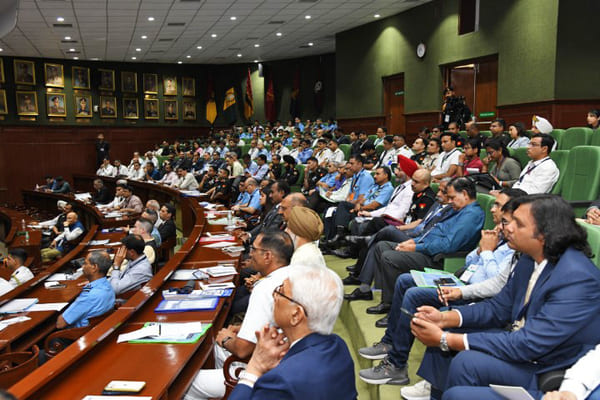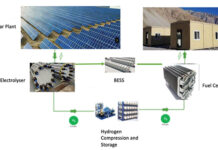Indian Military Review and the Centre for Joint Warfare Studies (CENJOWS) organised Unmanned Aerial Systems India 2023, seminar & exhibition, on 28 August 2023 at the Manekshaw Centre, New Delhi.
The seminar provided a platform to the industry to interact with the defence services and get an insight into their plans and requirements so that private industry could contribute in capability building. The seminar also updated the audience about the technological advances made by the DRDO.
Session 1 – Inaugural Session
Welcome Address. Lt Gen Sunil Srivastava, Director CENJOWS gave the welcome address and covered the canvas by underscoring the war fighting asymmetry infused by drones in recent conflict. Highlighting the exploitation of drones in offense and defence, along with their vulnerabilities, as demonstrated in the ongoing Ukraine-Russia war, the potential of manned-unmanned teaming and repurposing of commercial drones. While commenting on the drone threat scenario in the Indian context, he highlighted the immense progress made by the private sector, duly supported by policies and initiatives of the DRDO and the three Services.
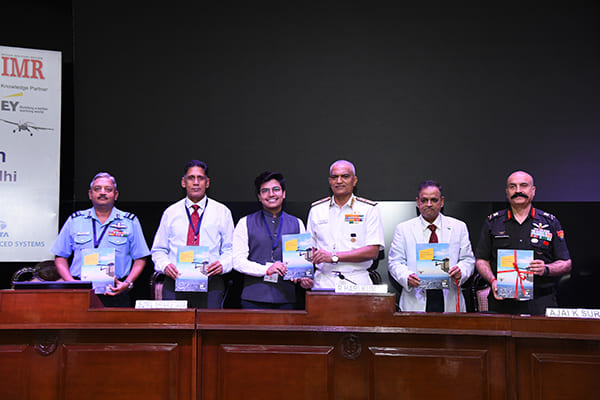

Inaugural Address. Admiral R Harikumar, Chief of the Naval Staff, delivered the Inaugural Address and underscored the importance of the Kartavya Kal and the need for Atmanirbharta in the growth of Indian technology and advancement. He mentioned the history of scientific achievements and innovations by mentioning Pushpak Viman, which was 20 centuries before Wright brothers, and the unprecedented and unmatched success of Chandrayan-3’s flight to the moon. He followed with the global landscape and Indian Navy’s role by mentioning 3 key issues. First, the ethical nature of the UAS development, second, the civil military fusion and third, the Indian Navy’s Vision for Unmanned Systems shared with the industry. He focused on leveraging civil tech for the military. He cited Armenia, Azerbaijan, where UAVs played a pivotal role and the exploitation of commercial UAVs in the ongoing conflict in Ukraine. He highlighted the ethical dilemma posed by the use of autonomous UAS. He argued that niche technology will shape the future to contribute towards Atma Nirbharta in drones.
Keynote Address. The keynote address was given by Lt Gen Ajai Kumar Suri, Director General Army Aviation. He emphasised on the need for research and development citing the example of the Reaper drones of the US since the 1990s. He underscored the proliferation of drones in the recent conflicts, especially by Azerbaijan in 2020 and the ongoing conflict in Ukraine, where he cited the Russian report which states that about 10,000 drones were being shot down per month. He highlighted three distinct operational contexts in which UAS have been employed successfully. From the1990s, high-end systems like Reaper and Global Hawk were employed by the US but in uncontested airspace and a large number of high value targets were targeted. Then came the Armenia-Azerbaijan conflict in September 2020 which displayed mass employment of UAVs by Azerbaijan. Currently in the Russia-Ukraine war, there is a mass employment of both UAS and counter-drone systems.
Large scale introduction of autonomous systems on the battlefield will impact the operational concepts. Therefore, it is important to invest in technologies related to manned-unmanned teaming and auto flight. Previously industries with only a significant capital base could produce military grade systems however today startups and MSMEs are a better place to produce innovative solutions.
Special Address. A special address was given by Air Vice Marshal PV Shivanand, ACAS Ops (Air Defence) Air HQ. He started with emphasis on the civil-military domain and the fast developing UAS, which are ushering a revolution in military affairs. UAS have multi-faceted uses in all domains. He mentioned drone’s role in nations economy, agriculture, infrastructure, mining, HADR and surveillance.
He highlighted China’s loiter munition capabilities and DJI Mavic which costs only $200k, which is relatively inexpensive and is being used by both Russia and Ukraine. He focused on drones’ diversity and its sophisticated nature.
ALSO READ: EVENT REVIEW – Unmanned Aerial Systems India 2023
He laid emphasis on the counter drone capabilities such as jamming and spoofing, hard and soft kill and urged that as a nation India needs to invest in swarm drone technology and manned-unmanned teaming.
He focused on the role of startups and MSMEs towards inhouse production of drones when the global military drone market is expected to reach $57 billion. He said that while the USA, China and Israel were the first movers in this arena, Iran and Turkey are the champions of indigenisation.
The key sectors that are driving the Indian drone industry are agriculture, logistics and defence and that the Indian government has taken various measures to promote the growth of the drone industry such as creating a drone task force and launching a dedicated portal for drone operations. The implementation of the Drone Shakti scheme has revitalised the drone ecosystem through institutionalisation and creation of a structure to enable synergising the efforts of various stakeholders. The liberalised Drone Rules 2021 have made it easier for seeking drone operations and related clearances and nearly 90% of the Indian airspace is accessible to any drone user today.
With the investments nearing $50 million, the current fiscal is all set to be the best year for India’s drone industry and it is expected to grow at 7-8% in the next 5 years. He brought out the various measures taken by each service HQ to handhold and promote the indigenous drone industry like the Meher Baba Competition of the IAF and the various Make 1 and Make 2 proposals of the IA and the IN which have already fructified into some contracts and more on the way.
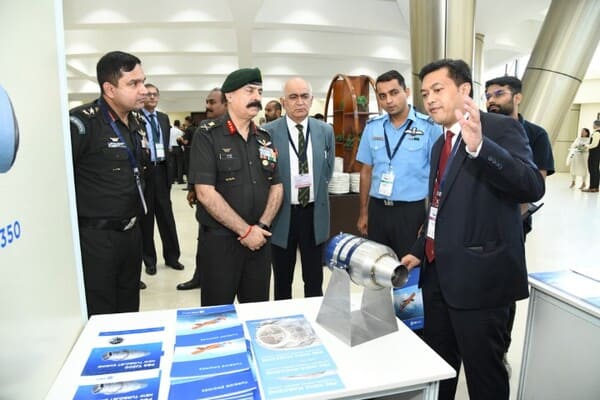

He highlighted the various emerging challenges like the implementation of the Beyond Visual Line of Sight (BVLOS) UAS, tracking of UAS to ensure requisite separation between UAS flights and between UAS and civil aviation flights, airspace management for all military UAS users in the tactical battle area as well as in peacetime and coherent management of all counter-UAS systems and that all these are in the process of being addressed.
He concluded by referring to the statistics from the Drone Industry Insight report which states that the global drone industry and the market size is forecast to reach growth of $54 bn by 2030 and that the military practitioners need to be alive to this domain and re-school and retrain to stay ahead of the challenge curve.
Industry Perspective. The industry perspective was given by Col KV Kuber, Director Defence and Aerospace, E&Y. He said that the Indian private drone industry has been majorly responsible for taking up the drone services sector wherein most of the advancements have taken place. His main arguments included the following:-
As per his analysis of the Russia-Ukraine conflict, the airborne drone attacks have achieved limited success, whereas the seaborne drone attacks have had stronger impact as the attacks on infrastructure and naval vessels have caused more serious damage and disruption and have demonstrated Ukraine’s capability and extended reach. Therefore, Ukraine is going to continue with these seaborne drone attacks and Russia needs to work out a strategy to counter them. Russia Ukraine drone warfare has made the UAS cheap and easier for exploitation in all domains – air, sea and land.
He brought out that at present there are 61 different UAVs in developmental stage in more than 50 countries across the world including Tapas and Rustom of India.
He highlighted the various unmanned systems projects that are underway and the various contracts awarded by the Indian armed forces to various startups that have helped them grow. However, he said that the various startups still face challenges in terms of funding. He emphasised on the concept of oasis funding and the need to entice larger funds to come into this space so that the startups can scale up not only in terms of capability but also capacity. He said that like Israel, India should become a natural exporter to the world.
He brought out various possible use cases for application of drone technology like airborne communication nodes, aerial retuning, strategic bombing, psychological warfare, information warfare, Manned-Unmanned Teaming (MUM-T), collaborative swarming, low-cost precision targeting, etc.
He said that when we talk about Buy Indian, we are talking about only 50% indigenous content and 50% is still being imported which includes critical components. This needs to be enhanced to much more than 50% by enhancing the capability to manufacture indigenously what we, at present, are not able to and raising the TRL in various technologies.
He noted that the last 3 years had witnessed a 300% growth in investments in the drone startup industry in India.
He emphasised towards dedicated funding by the defence ecosystem.
He highlighted the success and need for more competitions like the Meher Baba competition and the success of iDEX.
A knowledge paper on drones, prepared by Ernst and Young, was released after his address.
Session 2 – UAV Requirements
The chair of the second session, AVM George Thomas, ACAS (Plans), Air HQ opened the session by stating that there is a growing focus on the vast spectrum of UAS operations.
The session was intended to bring Military viewpoints on what the Armed Forces are seeking and how the UAV technology can meet their needs.
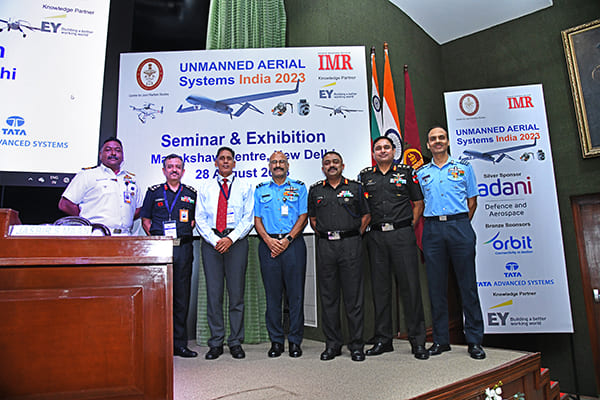

Gp Capt NK Chaubey, Gp Capt Ops (NBC and RPA), Dte of Ops (AD), Air HQ spoke on IAF’s UAV plans.
He mentioned the various MALE and HALE UAVs, aerial targets, UAS munitions, micro-UAVs and Counter-UAS systems presently in use with the IAF, their capabilities and the spectrum of roles that the IAF utilises them for.
He brought out that the requirements of the military UAVs differ from those meant for civil use in that they need to be capable of operating in all extremes of temperatures and terrain in contested airspace with the ever-present threat of enemy offensive action.
He mentioned the security challenges faced because of the proliferation of drone technology in all walks of life whether it be coverage of marriages & sports functions or national events using mini and micro drones and this has led to difficulty in airspace management too. The detection and neutralisation of drones, specially the micro and mini variety, is another area of concern and poses a major threat to national security.
With the ever-increasing numbers of UAS operators, availability of adequate frequency bandwidth for operating the UAVs will become difficult in future.
Covering the future plans of the IAF, he said that in view of the recent conflicts and keeping in mind the likely conflict scenario, the IAF plans to have an inventory of UAS encompassing the full spectrum to meet the IAF’s operational requirements. Work is in progress to enhance the capabilities of the existing platforms and procure modern platforms in the form of modern MALE UAVs with more capable payloads, HALE UAVs capable of undertaking operations in mountainous terrain including UCAVs and short and medium range SatCom enabled and controllable UAS munitions and easy to operate UAVs with minimum acoustic signature and high endurance for base defence of sensitive military installations. The IAF has already signed a contract for procuring Swarm Unmanned Munitions System
The IAF is thoroughly involved in the ongoing design and development programme of MUM-T being undertaken by HAL in coordination with the private sector. The IAF is also pursuing design and development of High-Altitude Pseudo Satellites (HAPS).
In line with the vision of Atmanirbhar Bharat, the aim is to have indigenous products which will also ensure a sustainable logistical supply chain in case of a long-drawn conflict.
He mentioned that all future procurements will have the mandatory requirement of interoperability, in case a similar system is being procured by any of the sister services to ensure optimum utilisation of resources.
The plan is also to have all the IAF’s RPAs networked to undertake operation from a central Mission Operation and Intelligence Centre (MOIC) with a vision to enhance the intelligence generation capabilities so as to be aid to all three services.
Other future plans for payload acquisition include multi-spectral EO payload with lasing capability, SAR, COMINT and ELINT payloads, radio relay equipment, IFF, TCAS, RWR and SatCom and all of those with AI and ML integrated in them.
Col Jasbir Singh Mann, Col Aviation-10 (RPAs), Army HQ gave a talk on Army’s HALE UAV requirements.
He mentioned the current inventory of MALE and HALE UAVs of the Indian Army. He said that the IA was responsible for monitoring the 15500 km long land border of the country 24×7 which needs far more advanced systems.
Putting forth the requirements of MALE and HALE UAV for the IA in front of the industry, he said that the UAVs need to have IFF and TCAS for airspace integration, due regard radar, RWR, encryption and anti-jamming & anti- spoofing capability for survivability. The RPAs should be capable of functioning in the challenging weather conditions, at 15- 20 km above earth. Attack drones must have adequate payload capabilities at high altitudes.
He said that the IA wants to procure EO/IR and SAR payloads with medium to long range which have 1 to 2 m of resolution.
The IA, in its future inventory of UAVs, is looking at procuring Runway Independent UAVs by 2025, SatCom MALE UAVs by 2027 and HALE UAVs by 2030 with capability to be controlled centrally, independent of physical location, AI integration and should be compatible and capable to communicate with the existing networks of the Indian Army and those of the sister services.
Col NR Choudhury, Col Inf-5, Army HQ made a presentation on Army’s Tactical UAV requirements.
He said that most of the present equipment available in the market is COTS or was designed for militaries elsewhere. It was felt that the industry falls short when it comes to modifying this equipment for the very specific and different requirements of altitude, weather and endurance of the IA. Therefore, a lot of R&D is probably required to meet the complete spectrum of Army’s tactical UAV requirement. The various UAV domains that the Army is looking at are battlefield transparency, lethality, mobility and survivability.
He then went on to cover the specific requirements for tactical UAVs which included vertical take-off and landing (VTOL) capability, high speed, better power management systems, a tactical range of 5-10 km with better payload carrying capability and endurance, altitude capability of 5500 km and modular design for ease of maintenance by troops rather than technicians. He said that since the tactical UAVs will be operated by troops rather than trained pilots, they need to have fail-safe mechanisms for catering for user errors, capability of auto take-off, autonomous navigation, autonomous mission execution, collision avoidance and auto landing. They also need to be man-portable, however, heavier logistic drones can be vehicle portable systems.
The various types being sought are nano drones, surveillance copters, tethered drones for continuous surveillance and mini UAVs for battalion level surveillance.
ALSO READ: EVENT REVIEW – Unmanned Aerial Systems India 2022
Coming to the specific requirements of surveillance drones, they need to have the capability of providing battlefield transparency beyond line-of-sight with all weather and day and night capable payloads, sensor to shooter integration, good endurance and stealth.
The Army is also looking to procure drones for logistics supply, drones for kinetic role and mobility drones for various tactical operations as well as casevac. All the systems need to be robust, ECM resistant, compatible with multiple GNSS and compatible with defence series maps.
Brig Manish Pande, Brig Ops, Arty Dte, Army HQ spoke on Artillery Requirement of Runway Independent RPAs.
Projecting the requirements from drones for supporting artillery operations, he said that the drones should be able to provide a shorter, faster, more responsive sensor to shooter link to support real-time engagement at distances of about 100 km, post-strike damage assessment, should require minimal infrastructure for quick and flexible operational deployment, have small cross- section to prevent detection, provide beyond LoS visibility and provide limited aerial surveillance capability to formation commanders.
He informed the audience that cases for procurement of 65 runway independent surveillance RPAs with minimum range of 80 km and endurance of 6 hours and for medium range precision kill systems (loitering munitions) are already under progress.
Cdr Hemant Shekhar, Cdr (AW)-RPA, Naval HQ spoke on Navy’s Experience with Drones and Future Plans.
He explained the importance of maritime surveillance in building up the Maritime Domain Awareness (MDA) and the contribution of RPAs to it. He mentioned the RPA assets currently in service with the IN.
Coming to the future plans of the Indian Navy, he said that it is looking to procure 31 HALE RPAs, naval shipborne UAS, HAPS for large area and sustained duration coverage, canister-launched loitering RPAs, unmanned surface vessels and unmanned underwater drones.
He went over the challenges being faced in the form of availability of satellite bandwidth and coverage for operation of UAS, availability of flight levels for naval UAS operations and requirement to initiate dialogue on regulations for non-segregated airspace for both manned as well as unmanned aircraft.
Following also emerged from the Q&A session:-
The DGAQA in Army HQ is working on having unified composite trial teams for consolidating the various requirements of the Indian Army and presenting them to the industry for providing solutions.
The MALE and HALE UAV requirements of the armed forces are being processed as joint service cases with single service lead and single unified testing.
Industry may feel that the requirements being projected by the services are too exacting to be fulfilled and in that way the services are not supporting the industry. However, what needs to be understood is that the prime job is to equip the soldier at the front suitably so that he or she can fight and therefore, the primacy remains of the war-fighter and the industry will have to catch up in that regard.
Though drone technology is a dual use technology and the military use began with the use of commercial drones in battlefield starting with roles like light logistics, but with the proliferation of counter-UAS systems, there is a challenge and an unavoidable need of hardening the UAS to permit it to operate in contested battlespace.
Session 3 – Industry’s Potential And Capabilities
The third session was chaired by Rear Admiral (Prof) Deepak Bansal (Retd), Department of Mechanical Engineering, IIT Madras. He opened the session by acknowledging the need of the UAS and that of collaboration between the services and the industry to maximise the potential. He brought up the challenges being faced by the startups and the MSMEs in the form of supply of critical spares for drones and difficulty in raising before inviting the panelists to deliver their talks.
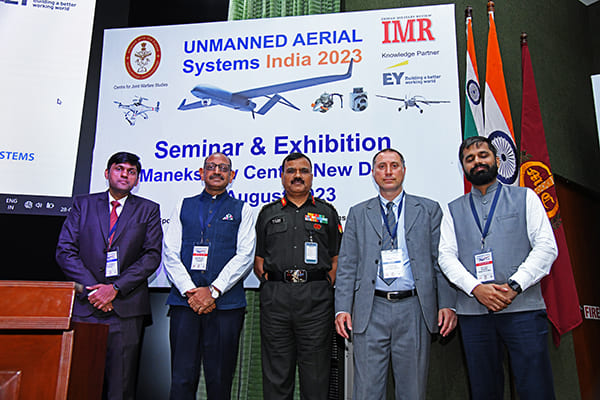

A Special Address was given by Smit Shah, President, Drone Federation Of India. He said that till 2014 there was a blanket ban on use of drones. However, realising the potential of drone technology and its role as a force multiplier in military operations and the significant use in multifarious civil applications, the government took a critical decision of liberalising the drone policy in 2021.
He recounted various initiatives and efforts undertaken with a central mindset that India has to become a leader in development of drone technology with a special focus on owning Intellectual Property (IP) and developing tech in-house.
The latest initiative has been the ease of exports under which export of drones with range up to 25 km and payload capacity up to 25 kg for exclusive use in civilian domain have been exempted from the purview of SCOMET policy.
He recommended that the armed forces should some prepare specific medium-term requirements so that the industry has its design targets and is able to develop more complex platforms and technologies.
Swapnil Jalundhwala, Adani Defence and Aerospace spoke on Make in India in Military UAS.
He gave the vision of his company and an overview of its strategic imperatives, the indigenous technologies that it was working on such as in the fields of UAS, counter-drone systems, satellites, missiles & munitions, small arms & ammunitions, cyber, AI & ML, etc.
He went on to introduce the various UAS indigenised by the company in the last few years in MALE, tactical, mini, micro categories as well as for logistics and agricultural applications. He covered in detailed the Drishti 10 (Starliner) UAS that features endurance up to 36 hours and LoS range of up to 350 km, is equipped with SatCom, ADS- B, IFF, collision avoidance system, DRR and RWR, has 4 hardpoints and an internal bay, and is integrated with advanced EOIR, SAR, MPR, ELINT, COMINT and Skeye payloads. It has autonomous take-off and landing capability and features single pilot operation and de-icing. The platform is STANAG 4761 certified which allows it to fly in civil airspace.
He also highlighted the range of loitering munitions and also the counter UAS system offered by the company.
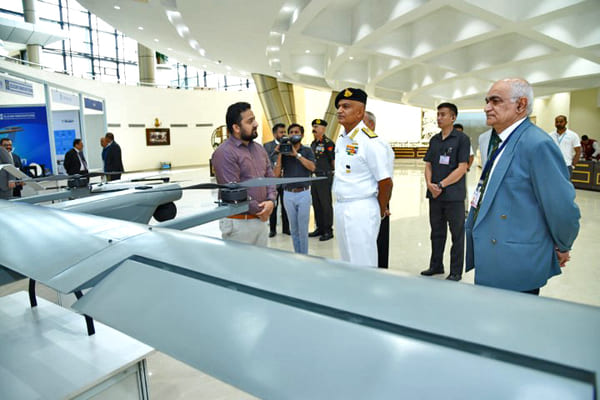

Ran Weinstein, VP Sales & Mktg, Orbit Communication Systems spoke on Orbit Full Communication Suite for UAVs.
He introduced his company to the audience and touched upon its main product segments namely airborne audio, mobile satellite communication and ground-based fixed and transportable telemetry and tracking systems.
He then offered some insight into the Orbit UAS Communication Solutions of the company comprising MPT-Airborne VSAT, LOS-Ground Line of Sight and AMS-Radio Gateway. The airborne VSAT is offered by the company in various sizes for use with platforms of varying sizes in Ku and Ka bands.
He also touched upon the UAV MRO facility for Heron and Searcher UAVs of the company and the services offered under the program.
Following also emerged from the Q&A session:-
The Indian Navy’s Unmanned Roadmap for air, surface and subsurface systems is available online in the public domain for the industry to refer to and come up with solutions. The timelines, numbers and other details of procurements could be found out using the link provided therein.
A document named Technology Perspective and Capability Roadmap, first published in April 2013 by MoD, is available online for reference of the potential manufacturers. The document provides to the industry an overview of equipment that is envisaged to be inducted into the Indian Armed Forces up to the late 2020s. This document intends to drive the technology development process that the industry may like to pursue. This roadmap may guide the industry in planning or initiating technology development, partnerships and production arrangements. The document was revised in 2018 based on the inputs received from the industry and business organisations for making it more informative.
The NSCS is working on addressing the issue of how to capture talent in schools from class 7th onwards and in colleges into the military domain towards the concept of ‘scholars becoming soldiers and soldiers becoming scholars’.
Session 4 – Innovations and Research & Development
The chairman of the fourth session, Cmde AP Golaya, VSM, OIC Technology Development Acceleration Cell, Naval Innovation & Indigenisation Organisation (NIIO), Naval HQ, said that India did not miss the industrial age but moved from agricultural age to information age without spending sufficient time in the industrial age and, therefore, the manufacturing ecosystem did not develop the way it should have. But as the world is shifting to the information age, suddenly the gap between India and the leading nations has narrowed and the startups can narrow this gap further. He said that more important than manufacturing is owning the IP. The companies who are doing the cutting-edge work need to be identified and nurtured. He was of the opinion that a QR based approach doesn’t work for innovation. Probably, startups know more about technology than the services and therefore, instead of preaching, we need to start listening. He ended his remarks by stating that standardisation is the enemy of innovation.
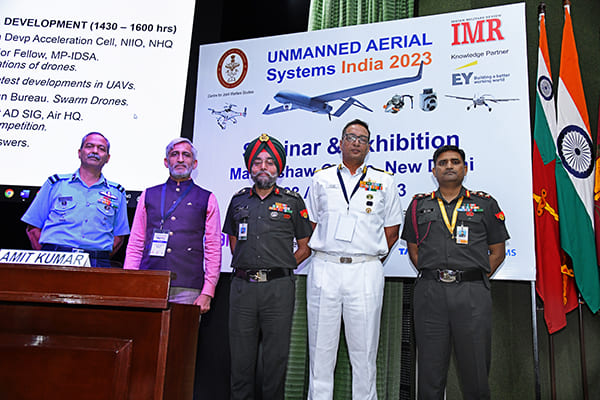

Dr S Rajagopal, Scientist G, ADE, DRDO spoke on Latest Developments in UAV.
He began with mentioning the various projects other than UAVs under development at DRDO that include the LCA FCS, simulators, cruise missiles, Remotely Piloted Strike Aircraft (RPSA) and aerial targets.
He said that the two main projects that DRDO is working on for ISTAR applications are the TAPAS and the Archer UAVs.
ADE is the nodal agency for developing the MALE class TAPAS UAV along with various other DRDO laboratories working on the various subsystems, the services giving the requirements and the PMT for flight testing. The ADE is mainly focussing on the design and the development is being done through various MSMEs. HAL and BEL are the production partners for the project. The induction of production partners has accelerated the progress significantly. He also made a mention of the various indigenous technologies achieved by DRDO.
He also covered the various tests that have been conducted for the project. He said that the tri-service capability requirements are likely to be met in the next four to five years. He mentioned the Single Engine Twin Boom (SETB) variant of TAPAS which is likely to meet all the PJSQRs of the services.
He quickly touched upon the Archer project which is an armed reconnaissance UAV based on Rustom-1. He covered the various requirements set forth for the project and the status of the various flight trials conducted.
Gp Capt (Dr) RK Narang, Fellow at MP-IDSA spoke on Developments in the Civil Military Fusion in Unmanned Aerial Systems.
He examined the civil component of the civil-military fusion. Talking about Civil Military Fusion (CMF) in UAS, he said that there are three basic guiding principles:-
- We want to become a global drone hub.
- We want to become Atmanirbhar.
- We want to have a research-led industry.
- He highlighted CMF as a strategy that optimises complementarities across the civil and military domains.
China articulated the policy of CMF with Chinese characteristics in 2007 and elevated it to national strategy in 2015-16. The USA has its own CMF or Civil- Military Integration policy.
- He brought out the advantages of CMF as:-
- It leverages civil technologies for military applications & vice-versa.
- It increases volume and economic viability.
- It reduces development timelines.
He presented the various civil drone RD&I projects and initiatives of the USA, Europe, China and India. He emphasizes that the projects of the USA and Europe had three characteristics – funding, focussed targets and timelines. China paid a lot of attention to ecosystem building – 13 testing sites were established; a lot of delivery drone trials were conducted.


In India’s case, he examined, the DGCA is an attached office to the Ministry of Civil Aviation which has a Drone Dte but does not have a RD&I initiative.
He said that though we have the target of becoming a global drone hub by 2030 but there are a lot of gaps in the policies and initiatives, especially in the civil UAS space, to realise that target.
Comparing the Indian civil RD&I with those of USA, Europe and China, he brought out the following deficiencies:-
- No designated ministry for civil drone RD&I.
- No government funded civil drone RD&I projects.
- No government led academic Centres of Excellence.
- No projects with definite goals and timelines (except BVLOS industry led initiative).
- No technical selection of testing sites, it is based on funding.
- Inability to formulate policy on operation, standards and certification of drones above 150 kg due to absence of civil drone RD&I testing and validation programme.
At the end, he suggested following as the way forward for CMF in India:-
Ensuring a robust civil drone RD&I ecosystem for CMF by following:-
- A nodal ministry for drones (probably MoCA).
- Civil drone RD&I and self-reliance to be included in National Civil Aviation Policy.
- Create RD&I vertical in MoCA.
- Civil drone RD&I Roadmap.
- Government funded Civil drone RD&I projects.
- Civil-military IDDM projects on critical UAS technology/sub-systems & UTM.
- Creation & implementation of IDDM & positive indigestion list to all ministries.
- Civil drone Standards & Certification based on trials & validation.
- Articulation/standardisation of drone testing sites specifications.
- Mechanism for sharing of military drone technology/sub-systems with the industry.
- Increase collaboration with industry on tactical/MALE and HALE UAS projects.
- Increase R&D funding by private industry.
Col Amit Kumar, Col Arty & Avn, Army Design Bureau spoke on Swarm Drones.
He cited examples from recent conflicts where swarm drones were used for carrying out attacks like those the Russian airbase at Khemmiem and the Tartus Naval Facility in 2018, on Saudi Aramco oil production facilities at Abqaiq and Khurais in 2019 and the instances of swarm drone attacks in the ongoing Russia-Ukraine conflict by both Russia and Ukraine.
He presented a global scan of swarm drone technology with the Predix micro drones, the LOCUST system, the X-61A Gremlin project, the Autonomous Multi-domain Adaptive Swarm of Swarms (AMASS) and the Offensive Swarm-Enabled Tactics Programme (OFFSET) of the US, the Russian Flock-93 project and the Lancet-3 based Product-53, the Chinese CH-901 LM with 48 tube launchers, the French Icarus Drone Swarm and the Turkish Kargu drones.
The military applications of swarm drones would include ISR, SEAD, target saturation, flank protection, communication, EW, CT operations, operations in built-up areas, minefield clearance, logistics resupply in forward areas, and decoys.
He brought out the challenges of command & control, communication and computing power in managing the swarm, endurance, collision avoidance and the ability to launch such a large swarm of drones in a short period of time.
He suggested that the solutions to these challenges could be found in integration of AI and novel algorithms to reduce the computing load, designing the drones to be tube or air launched so that large swarms can be launched within a short period of time and achieve extended ranges despite limited battery life.
He concluded by emphasizing the need to simultaneously develop counter-swarm systems.
Air Cmde SM Paranjape, Team Ldr, Project AD Services Interface Gp, Air HQ spoke on Meher Baba Swarm Drone Competition.
He elaborated that the idea behind the Baba Meher Singh Swarm Drone Competition was to fuel innovation and ideas, refine the execution skills, promote scientific attitude and honest competitive culture. The IAF involved by way of investment of time, funds, fields and expertise.
The purpose of the competition was defined as “Integrate elements of national potential for a common purpose and compete to solve a problem statement”. The role of the Indian Air Force was to add value as a catalyst.
The value edition by the IAF was done by:-
- Identifying gaps in capability
- Objectively defining nation’s requirement
- Defining CONOPS and providing testing fields and facilities
- Providing operational & engineering experience in terms of technological & operational peculiarities of military aviation
- Designing tests & target layout to test technology limits and human factors
- Making Soldier-Scientists: UAS Operators, Swarm Algorithm Scientist, CVML & Sensor Fusion Specialists.
Session 5 – Counter UAVs
The last session of the day was chaired by AVM Rajiva Ranjan, ACAS Ops (Space), Air HQ. He began the session by explaining the innovative manner in which the Russian forces have managed to protect themselves against the Ukrainian drone attacks using their EW and AD systems. He said that while the drones are rapidly developing and have reached a particular stage of maturity, counter drone systems are catching up.
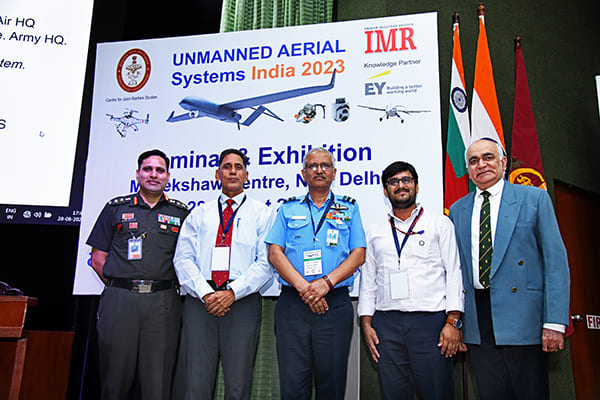

Col Rakesh Zutshi, Col AD (Ops & Op Logistics), Dte of Army Air Defence, Army HQ spoke on Countering the UAV Threat.
He gave examples of threat beyond manned aircraft and the disproportionate outcomes and challenges in identifying the intent. The UAS threat manifestation, the CUAS operation philosophy and the challenges for development of CUAS equipment were the main focus of his presentation.
He said that while earlier aerial threat was expected to manifest from large distance to short distance while crossing from outer to inner layers of defences, today, aerial threat will not follow a defined sequence and may manifest from any range and altitude bracket or may manifest simultaneously in all.
Bringing out the characteristics of aerial threats in the form of UAS, he said that they may be as small as less than 5 metre in size with RCS as low as 0.01 square metre or could take the form of a loitering munition.
Analysing how a UAS system can be countered, he began by considering countering the UAS EM spectrum by exploiting the vulnerabilities of the control signals of the GCS link, the satellite link with GNSS, the data links and even the onboard sensors.
He presented the threat mitigation solutions in countering the UAS systems with soft kill such as jamming and spoofing, and hard kill using small arms, AD guns & missiles, DEWs (Lasers & High Powered Microwaves) and other measures like drone killers & drone catcher nets.
The pre-requisite AD structure for C-UAS would include:-
- Surveillance and detection using active or passive sensors.
- Identification and tracking.
- Destruction or neutralisation using hard or soft kill systems.
- Communication and battlefield management to prevent fratricide.
- The challenges in development of C-UAS systems are:-
- Low RCS detection capability where AESA/ GaN technology is of help.
- Requirement of a man-portable or mobile system with on the move surveillance, detection and engagement capability for protection of mobile formations.
- Transmission power management for EES.
- Cost effective mitigation solution.
- More precise beamwidth to reduce collateral damage.
- Integration with tactical C3I system for situational awareness.
He concluded by emphasizing on the need for development of a variety of integrated C-UAS systems suitable for varied terrain, range and targets.
V Kishore Kumar, Scientist D, DLRL, DRDO spoke on D4 Anti-Drone System. He talked about the requirements for Counter Drone System (CDS) projected to DRDO based on which it developed the D4 (Drone Detect Deter Destroy) Anti-drone System. The major components of the D4 system include a drone tracking radar, a soft kill system consisting of an electro- optic tracking system and a RF detection & jamming system, and a laser DEW hard kill system all of which are connected to a command post.
DRDO is also working on developing a Killer Drone System (drone to drone attack) and a High Power Microwave System.
He explained the operation philosophy of the D4 anti-drone system in detail and also covered the capabilities of the radar system. The D4 system is capable of jamming the communication link signals of a RC drone as well as the GNSS signals of an autonomous drone.
DRDO has developed a vehicle mounted configuration with soft kill and hard kill options, a tripod-based system for the IAF and a vehicle-based system with all four components for the Indian Navy and the Indian Army. BEL is the production agency for the system.
DRDO has developed another long-range system for the Indian Army called the Jammer Anti-UAV (JAU) which has ESM & ECM capability against modern UAVs and is capable of engaging UAVs ranging from nano to MALE & HALE class.
AVM Rajiva Ranjan summarised the session, saying:
The taxation for R&D came down from 200% in 2016 to 150% and subsequently to 100% in the 2021-22 budget. But in specific segments, we need to take up and ask for the R & D budget to be tax free at higher ranges especially when we are thinking of becoming a global drone hub. The taxes on imports of Tier- 2 and Tier-3 categories, which are high, need to be reduced.
Under the National Research Foundation, we should identify a few of the industries and a few of the colleges along with users to make a centre for technology development.
Almost 50% of the money and schemes under TDF is utilised by the DRDO for developing certain technologies for themselves and the DPSUs. Services need to be wise to utilise this additional money that they get over above the capital budget to get their capabilities and ask for technology rather than systems.
In those categories where the technologies are being imported, as per the provisions of the government, we should partner with the academia, create a Centre of Excellence for that technology that is then absorbed.
Startups need to be smart to utilise the provisions of the government like the Program VAIBHAV. The industry should be wise to collaborate with institutions like IITs, MIT, etc., ask for a particular scientist from abroad under Program VAIBHAV, the funding being done by the government, and acquire the technology.
Lt Gen Sunil Srivastava, Director CENJOWS summarised the key takeaways of the seminar where he highlighted the need to finding indigenous solutions to the services’ specific requirements urgently in order to overcome the challenges faced in customising the hardware sourced from abroad, to provide the industry with the services’ mid and long-term requirements so that they have a goal to work for, to examine the requirement of exploiting military frequency bands for communication due to inadequacy of commercial frequencies. He said that much needs to be done as far as unmanned traffic management, synchronisation and airspace management is concerned and one needs to follow the systems of systems approach.
Maj Gen Ravi Arora, Chief Editor, Indian Military Review, ended the seminar with a vote of thanks to the Director CENJOWS for having personally selected the speakers and prepared the program for the event, all the stakeholders for their efforts and the delegates present for making the event a success.


